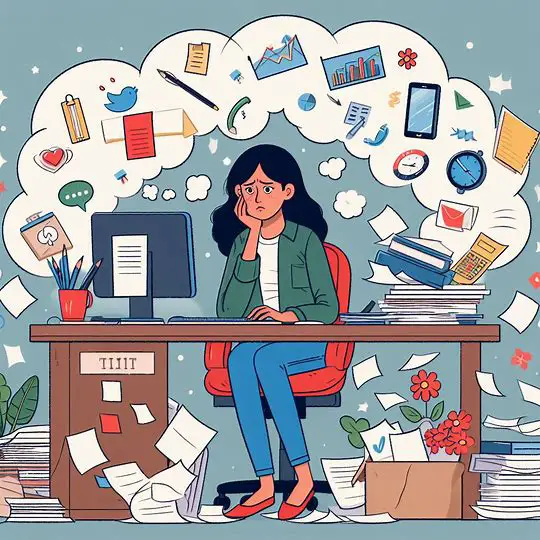Discover effective methods to manage work anxiety with our expert tips. Take control and achieve a calmer, more productive work life.
Table of Contents
Introduction – Work Anxiety
Work anxiety is an increasingly common condition that manifests as a persistent state of stress or fear related to the workplace. It can stem from various causes, including high-pressure job environments, interpersonal relationships at work, or job insecurity. This condition affects the individual experiencing it and can affect workplace dynamics and performance. It’s estimated that a significant number of Americans will experience work-related anxiety at some point in their careers, indicating a need for strategies to manage this issue effectively.

Understanding work anxiety is critical to developing effective management and coping strategies. It’s important to recognize the signs of anxiety at work, which can range from physical symptoms like headaches or stomachaches to emotional symptoms such as irritability or a sense of dread about work tasks. Once identified, individuals can employ practical coping strategies and seek professional advice to help mitigate the effects of workplace stress. Employers also have a role to play, providing support systems and fostering an environment that promotes mental well-being.
Key Takeaways
- Work anxiety is a prevalent concern that can impact both individuals and workplace environments.
- Recognizing the signs of work-related anxiety paves the way for effective management and coping strategies.
- Both individuals and employers can contribute to addressing work anxiety, promoting well-being and productivity.
Understanding Work Anxiety

In this section, the focus is on clearly defining work anxiety, identifying its common symptoms and signs, and unraveling the causes behind this specific type of anxiety.
Defining Anxiety and Work Anxiety
Anxiety is a normal and often healthy emotion, characterized by feelings of tension and worried thoughts, and may be accompanied by physical changes such as increased blood pressure. When a person regularly feels disproportionate levels of anxiety, they may have an anxiety disorder. Work anxiety refers to stress induced by work that leads to continuous worry or fear about work-related responsibilities.
Recognizing Symptoms and Signs
Work anxiety manifests through various symptoms that can affect both the person’s mental and physical well-being. Common indicators include:
- Persistent worry or fear about work tasks
- Feelings of dread about going to work
- Irritability or uneasiness when thinking about work
- Overreacting to work situations
- Physical symptoms like fatigue, racing heart, and dry mouth
- Cognitive effects such as concentration difficulties or trouble sleeping
Exploring Causes
Numerous factors contribute to the development of work anxiety, including:
- Excessive stress from overwork or job insecurity
- Lack of control over workplace decisions
- Unclear job expectations or excessive workload
- Workplace dynamics or fear of poor performance review
Understanding these elements helps in the identification and management of work anxiety.
| Key Findings | Related Keywords and Entities |
|---|---|
| Work anxiety is stress related to work that causes excessive worry or fear | Stress, Worry, Fear |
| Symptoms can be both physical—like racing heart—and psychological, such as irritability | Symptoms of Anxiety, Racing Heart, Irritability |
| Causes include high stress, unclear expectations, and poor work environment | Causes of Work Anxiety, Stress |
An Overview of Work Anxiety – Verywell Mind
Workplace Anxiety: Signs, Causes, Tips to Cope – Healthline
Effects on Individual Well-Being

Work anxiety has tangible consequences on individuals’ physical and emotional health, and it can significantly impact their work performance and productivity.
Physical and Emotional Impact
Anxiety in the workplace can manifest physically through symptoms such as headaches, fatigue, and gastrointestinal issues. These ailments are signs that the body is under stress due to work anxiety. Individuals may also experience symptoms of depression, which can exacerbate the emotional toll of work-related stress. The interaction between anxiety and mental health challenges often leads to a decrease in an individual’s overall well-being.
| Physical Symptoms | Emotional Consequences |
|---|---|
| Headaches | Mood swings |
| Fatigue | Irritability |
| Sleep disturbances | Depression |
Key findings show that these physical and emotional issues are highly correlated with work stress and can lead to reduced job satisfaction. Verywell Mind provides an insight into how these effects can transcend the workplace and impact personal life.
Performance and Productivity
Work anxiety can impede an individual’s ability to concentrate, decreasing their performance and impairing their quality of work. The constant pressure and worry may lead to serious burnout, a state of emotional, physical, and mental exhaustion caused by excessive and prolonged stress. Burnout results in individuals feeling overwhelmed and unable to meet constant demands significantly affecting productivity.
| Impact on Work | Effects on Productivity |
|---|---|
| Reduced job performance | Diminished efficiency |
| Quality of work suffers | Lower output |
| Difficulty concentrating | Hindered problem-solving |
Healthline highlights workplace anxiety’s wide-ranging symptoms and their detrimental effects on performance. Additionally, Choosing Therapy emphasizes that proactive coping strategies can prevent workplace anxiety from evolving into chronic stress, which negatively impacts a person’s performance as well as their physical and mental health. (Choosing Therapy)
Workplace Dynamics and Interpersonal Relations

Effective navigation through workplace dynamics and the betterment of interpersonal relations can substantially reduce workplace anxiety. Employees face challenges such as bullying and harassment, which can disrupt the sense of security necessary for productivity and professional growth.
Navigating Coworker Interactions
Coworkers significantly influence one’s day-to-day work experience. Establishing clear boundaries and addressing imposter syndrome can mitigate anxiety and improve cooperative efforts. Engaging in open communication and fostering an inclusive environment that discourages discrimination is important.
Key Strategies for Navigating Interactions:
- Communicate expectations clearly.
- Encourage team activities that build trust and cohesion.
Dealing with Bullying and Harassment
Bullying and harassment pose severe threats to an individual’s well-being. Organizations must enforce policies that protect employees while promoting respect and equality in the workplace. Employees should be empowered to report incidents without fear of retribution, and employers should provide training on identifying and preventing such behavior.
Key Responses to Bullying and Harassment:
- Implement a zero-tolerance policy for bullying and harassment.
- Provide accessible reporting channels and support systems.
Relevant Sources:
| Topic | URL |
|---|---|
| Workplace Dynamics | Psychology Today |
| Bullying and Harassment | ResearchGate |
Key Findings:
| Finding | Relevant Keyword(s) |
|---|---|
| A supportive environment mitigates anxiety. | Workplace Dynamics, Interpersonal Relations |
| Policies against bullying can empower employees. | Bullying, Harassment |
Practical Coping Strategies

Effective management of work anxiety calls for a deliberate approach that includes self-care and lifestyle adjustments, as well as seeking professional help. Below are curated strategies that one can employ.
Self-Care and Lifestyle Changes
Incorporating self-care practices and lifestyle changes can mitigate the effects of work-related anxiety. Regular exercise, for instance, is known to reduce anxiety symptoms by releasing endorphins that act as natural painkillers and mood elevators. Moreover, efficient time management can alleviate the pressure of deadlines, with the Pomodoro Technique being particularly useful as it breaks work into intervals, typically 25 minutes in length, followed by short breaks.
| Key Strategy | Description | Source URL |
|---|---|---|
| Exercise | Engages the body and mind, promoting mental well-being. | Psych Central |
| Time Management | Helps organize tasks and reduce the stress of deadlines. | Psychology Today |
| Pomodoro Technique | Encourages frequent breaks to improve focus and concentration. | Healthline |
| Being gentle with oneself through self-compassion can improve mental health and resilience, fostering a more positive workspace experience. Additionally, ensuring sufficient sleep, maintaining a balanced diet, and staying hydrated are essential physical needs that directly affect psychological health. |
Professional Help and Therapies
When self-managed efforts are not sufficient, seeking the help of a mental health professional can provide more personalized coping strategies. A therapist can help individuals understand their anxiety triggers and develop a comprehensive plan to manage them. Cognitive-behavioral therapy (CBT) is one evidence-based approach that helps individuals reframe negative thought patterns that contribute to anxiety.
Medication, prescribed under the guidance of a healthcare professional, can also play a role in managing work-related anxiety for some individuals. It’s essential to have open and honest communication with a healthcare provider to determine the most appropriate treatment plan.
| Strategy | Description | Source URL |
|---|---|---|
| Mental Health Professional | Offers personalized strategies and support for managing anxiety. | Positive Psychology |
| Cognitive-Behavioral Therapy (CBT) | A structured, time-limited approach to understanding anxiety. | Psych Plus |
| Medication | May be prescribed to alleviate severe symptoms of anxiety. | Psych Central |
Maintaining open communication and actively participating in therapy sessions can significantly enhance the effectiveness of these professional interventions.
Legal and Professional Considerations

In the workplace, legal and professional considerations concerning anxiety must address the protections and obligations under the Americans with Disabilities Act, as well as the nuances involved in Discussing with Employers about one’s mental health condition.
Americans with Disabilities Act
The Americans with Disabilities Act (ADA) offers protection to employees suffering from anxiety, which is often covered when it substantially limits one or more major life activities. Under the ADA, employees are entitled to reasonable accommodations provided they do not impose undue hardship on the operation of the business. Employers are prohibited from discriminating against individuals with disabilities, which includes not only physical but also mental health conditions like anxiety and depression.
Discussing with Employers
When approaching the sensitive topic of mental health with an employer, it’s important that employees understand their rights and the proper way to navigate this disclosure. The Anxiety and Depression Association of America (ADAA) recommends clear communication about the condition, focusing on the impact it has on job performance and the specific accommodations being sought. Though job security is a common concern, the ADA provides a level of protection against job loss solely due to disability disclosure.
| Key Findings | Relevance |
|---|---|
| ADA provides job protection for anxiety | Legal rights |
| Employees must disclose condition to seek accommodations | Professional duties |
Relevant URLs:
| Organization | URL |
|---|---|
| ADA | https://www.ada.gov/ |
| ADAA | https://adaa.org/ |
Building Resilience and Seeking Growth
In the face of workplace challenges, from feeling overwhelmed to managing work-life balance, developing resilience and seeking personal growth are critical. They equip individuals to handle uncertainty and combat the dreaded Sunday scaries. Now, let’s explore specific strategies to foster emotional strength and improve work-life harmony.
Developing Emotional Strength
To develop emotional strength, one must acknowledge and address feelings of being overwhelmed. Fostering resilience involves recognizing and halting catastrophizing thoughts, a habit exacerbated by the COVID pandemic. Strategies like focusing on the present and practicing mindfulness can help mitigate distraction and improve one’s focus. Further insights on building personal resilience can be gleaned from the American Psychological Association.
Improving Work-Life Balance
Improving work-life balance demands intentional actions and setting firm boundaries between professional and personal life. Regular physical activity, sufficient sleep, and leisure activities contribute to better physical health, which is vital for maintaining balance. Techniques like time-blocking can ensure that one’s personal time is respected, helping to lessen anxiety related to work. The concept of ‘vigor’ mentioned by Positive Psychology is critical as one applies energy positively towards work and personal life.
| Key Strategies | Source URL | Related Keywords |
|---|---|---|
| Building Emotional Strength | https://www.apa.org/topics/resilience/building-your-resilience | resilience, focus |
| Improving Work-Life Balance | https://positivepsychology.com/resilience-in-the-workplace | work-life balance, vigor |
| Key Findings | Implications |
|---|---|
| Resilience can be learned | One can build emotional strength over time |
| Balance requires boundaries | Setting clear separation improves work-life balance |
Through these strategies, individuals can become more adept at navigating workplace adversity while maintaining their well-being.
Frequently Asked Questions
This section provides valuable insights into handling work-related anxiety and outlines various strategies and signs to look for if you suspect you’re affected by this condition.
How can I effectively manage anxiety in the workplace?
Effective management of workplace anxiety typically involves recognizing stress triggers and employing stress-reduction techniques. It may be helpful to communicate with your manager if you require additional support.
What strategies are recommended for coping with anxiety at work?
Strategies to cope with work-related anxiety include organizing tasks, setting realistic goals, and ensuring regular breaks. Time management and mindfulness exercises also come highly recommended. More details can be found on tips to overcome work worries.
What are common signs that I might be experiencing work-related anxiety?
Common signs of work anxiety include reduced job performance, difficulty concentrating, and feelings of dread regarding work-related activities. It can also affect personal relationships and impact your overall health.
What steps should I consider if my job is causing me significant anxiety?
If significant anxiety stems from your job, consider discussing your concerns with a trusted supervisor or HR representative. Evaluating workload and responsibilities may be necessary; sometimes, seeking professional help is the best course of action.
In what ways can therapy or counseling address work anxiety?
Therapy or counseling can provide personalized coping strategies and behavioral techniques to manage anxiety. Professionals can assist in identifying the root causes of stress and developing a tailored plan to address them.
How does work anxiety differ from general anxiety, and what does that mean for treatment?
Work anxiety is specifically linked to the work environment and can be triggered by job-specific stresses, while general anxiety is more pervasive and doesn’t tie to one specific cause. Recognizing this difference is crucial for treatment, as interventions may be more focused on occupational therapy and workplace adjustments.
| Key Findings | Related Keywords | Sources |
|---|---|---|
| Effective communication with supervisors can alleviate anxiety. | Workplace anxiety, Communication | Asana Resource |
| Regular breaks and mindful exercises are beneficial coping strategies. | Mindfulness exercises, Coping strategies | Verywell Mind |
| Identifying early signs of work anxiety leads to better management. | Early signs, Work anxiety | Healthline |
| Professional help is sometimes necessary for significant job-related anxiety. | Professional help, Job-related anxiety | Centre of Excellence |
| Therapy addresses personalized strategies and root causes of work anxiety. | Therapy, Root causes | Brain & Behavior Research Foundation |
| Occupational therapy may be important for work-specific anxiety treatment. | Occupational therapy, Anxiety treatment | Centre of Excellence |




